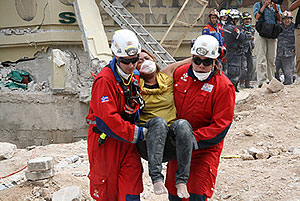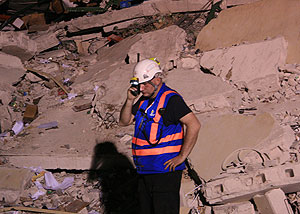PORT-AU-PRINCE, Haiti — Jan. 18, 2010 — Twenty-three hours after Haiti was struck by a 7.0-magnitude earthquake, Gisli Olafsson touched down in Port-au-Prince.
“The scene was horrible, with large parts of the city collapsed, bodies lying in the streets, and people trying to seek shelter outdoors since they were afraid of aftershocks,” said Olafsson, a disaster management technical advisor for Microsoft’s Global Strategic Accounts team. “As you drive through the city, power cables are down in many places and rubble is often in the street, making it hard to get around.”

Members of Gisli Olafsson’s search and rescue team in Haiti carry an injured woman from a collapsed building.
Olafsson had arrived to lead Iceland’s Urban Search and Rescue team, the first international rescue team to arrive in Haiti. The death toll remains unknown – the International Red Cross estimated on Thursday that it could be as high as 50,000. The organization also estimated that 3 million people — a third of Haiti’s population — may need emergency relief.
A groundswell of Microsoft employees has rallied to help raise money, with 1,600 employees already contributing over US $280,000 to 104 nonprofits working in Haiti. In addition, Microsoft made an initial commitment of US$1.25 million, which includes cash and in-kind contributions.
“The response has been phenomenal,” said Akhtar Badshah, senior director Global Community Affairs. “It’s a massive tragedy, and we are very humbled by the response from our employees and the response from our relief organization partners who are moving very quickly to bring in all the help that is needed.”
Helping at the scene
Olafsson said aftershocks were still occurring every hour or so on Thursday and Friday.
“Almost everyone you meet has lost someone from their family,” he said Thursday evening. “People are grieving and hoping their loved ones can still be found, but hope is going down every hour that passes.”
For the past 17 years, Olafsson has been a search and rescue volunteer. He is the team leader for Iceland’s Urban Search and Rescue team, which responds to large-scale earthquakes around the world.
His was the first international rescue team to touch down in Haiti. While he is there, he’s leading a team of 35 who are responsible for searching for people in collapsed buildings and attempting to free them from the rubble.
“During the first day of operations we successfully managed to get three women out of a collapsed supermarket,” he said. “Sadly, the number of deceased we discovered was much higher.”
Finally, the team had to move away from the supermarket, leaving Olafsson with the tough job of explaining why to a large crowd looking for their relatives. “It is hard to be the one breaking people’s hopes of their relatives still being alive,” he said.
In 2008, Olafsson flew to China as part of Microsoft’s disaster response efforts after a similarly devastating earthquake hit that country’s Sichuan Province. “This earthquake reminds me of that experience, but in many ways it is different since Haiti is one of the poorest countries in the world,” he said. “Their lives were hard enough before the disaster happened.”
Looking for loved ones
Jemima Herman, partner recruit lead for Microsoft’s US Worker Information Group, has family in Haiti. Both of her parents were born there, and four of her cousins live in Port-au-Prince. After the earthquake she tried to reach her father in Brooklyn, where he lives and where Herman was raised. She discovered he had left for Haiti the night before to visit his ailing mother.

Gisli Olafsson, a disaster management technical advisor for Microsoft’s Global Strategic Accounts team, is leading Iceland’s Urban Search and Rescue team, the first international rescue group that touched down in Haiti.
She and her mother, who is with her in Bellevue, Wash., spent a nerve-racking day trying to get in touch with him before finally receiving a call on Wednesday night. Fortunately, her father was with her grandmother in Aux Cayes, a small town in the southern part of the country, and they both were OK.
Now, Herman is doing her best to reach her cousins. She’s seeking help on Twitter, Facebook, and a number of sites that have sprouted up to assist people trying contact loved ones. She keeps watching CNN, hoping to catch a glimpse of a shirt or the back of a head that will identity one of her cousins. The images are painful for her to watch, she said.
“I don’t think people understand the magnitude of the devastation,” she said. “The fact that the country was already in such bad shape, it’s almost insurmountable pain piled on top of pain.”
Ongoing relief efforts
Within a few hours of the earthquake, Microsoft had activated its Disaster Response team, said Claire Bonilla, senior director of Operations Risk Management and the employee managing Microsoft’s response. Her team’s mission is to provide technology and support to help lead response agencies coordinate efforts and act quickly during a disaster, she said.
The Disaster Response team is working with groups across the company as they mobilize to help however they can, Bonilla said.
Visitors to Bing and MSN Web sites are being directed to ways they can support relief efforts. The Virtual Earth team is working to get images of Port-au-Prince to the relief organizations that need them. And Global Foundation Services, which runs Microsoft’s data centers, is working with the Red Cross to help ensure its Web site can handle the massive uptick in traffic as donations flood in.
“We have overwhelming support from just about every group in the company,” Bonilla said. “Product groups, services groups, customer and partner-facing groups have all been reaching out to us to see what they can do.” Employees wanting to help can visit an internal Web site and donate to a nonprofit working on the ground in Haiti, she said.
Badshah reminded employees that the tragedy will take years to overcome. “Many of the organizations are in it for the long haul, and they’ll continue to require resources as they move to the rehabilitation and rebuilding phase,” he said.
For now, he added, what organizations need most is cash to continue to provide basic services. That matches Olafsson’s assessment from the scene.
“People lack food, water and shelter,” Olafsson said.




